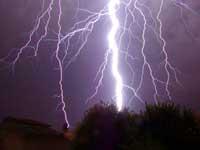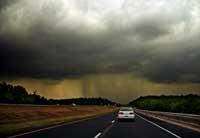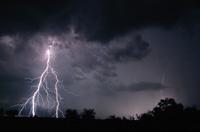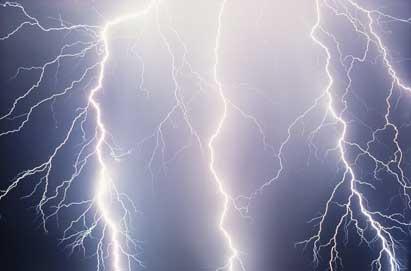Travel to the roots of lightning
2009/05/31 Lakar Iraizoz, Oihane - Elhuyar Zientzia

Rays usually occur in violent storms, called thunder embates, and this type of storms occur when creating clouds called cumulonimbos. These clouds have a vertical aspect that occurs in conditions of high ambient humidity and air heat: the heat makes the water evaporate and the steam rises and rises to the atmosphere. As we ascend, the ambient temperature is getting lower and, at any given time, the steam does not have enough energy to remain gas and becomes a small drop of water. These are the clouds.
The water drops accumulated in the clouds remain suspended and, in the case of the onimb cumulus, interactions occur between the accumulated water vapor molecules, the water drops, the ice drops, etc., and frictions. As a consequence, the electrons of the molecules are put to dance and move from one molecule to another. Something similar happens when a balloon is rubbed against a wool jumper, electrons pass from one to the other and both the globe and the jersey are loaded.
Because even in the clouds there are molecules that acquire positive charge and other negative. When taking the load, positively charged molecules accumulate at the top of the cloud and negatively charged at the bottom.

Clouds, called cumulonimbos, are a history of rays in humid and warm environments. (Photo: Nicholas T. )
This distribution of loads in the clouds is repeated on the ground. In fact, the electrons at the bottom of the clouds repel those of the soil and make them penetrate into it. In this way, the surface of the soil (top of the earth layer) acquires a positive load, while the deepest part of the earth is negative.
And then, the lightning
At that moment there are two surfaces with opposite load, and the difference is increasing, since more water is accumulating in the clouds, there are accumulated shocks and frictions, etc., and in the end that tension becomes unsustainable and the discharge, the lightning occurs.
The electrons are directed towards the terrestrial surface to remove the difference of load generated. The trajectory of the electrons is defined by air. In fact, the air itself is loaded, which facilitates the passage of electrons. However, not all air is charged in the same way due to dust particles and other bodies of air. Therefore, the electrons occupy a path of minimum difficulty, which is never a straight line, but in zigzag.

Distribution of loads in clouds and on Earth. In these cases it is very common for rays to occur. (Photo: Nicholas T. ).
The electrons that are passing heat up and expand the air instantly, which produces a noise we call thunder. However, we do not perceive the rays and thunder simultaneously. This occurs simply because the light and sound do not move at the same speed, the light moves a million times faster than the sound.
As the electrons move so quickly, the rays have a very reduced duration. Yes, the power is usually huge: Its temperature is about 30,000 degrees (five times the surface temperature of the Sun) and its intensity ranges between 5,000 and 340,000 amps. How can we not be shocked and sometimes fearful of such phenomena?
Published in 7K.

Gai honi buruzko eduki gehiago
Elhuyarrek garatutako teknologia






